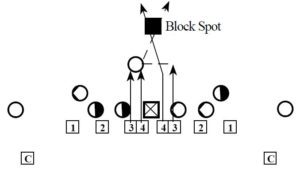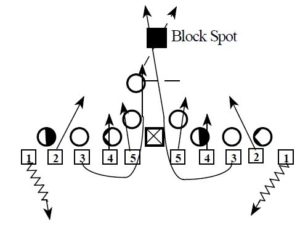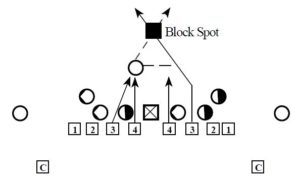Game planning will dictate what type of blocks that we will employ. However we have a few basic punt block schemes that are designed to attack man or zone schemes, as well as spread punt, tight punt and “big butt” punt alignments. We use built in return schemes, unless it is an all out block, which we call “Big Horn”.
When designing punt block schemes, it is imperative that you understand your opponent’s blocking scheme. Then design the block to take advantage of a possible weak blocker(s), either by overpowering or confusing them. In general, we like overload situations versus zone schemes, and twists versus man schemes. The block scheme must have players occupying the protector(s) and defenders who are responsible for fakes, either run or pass. The punt return is still a defensive play until the ball is kicked, therefore the alignment must be gap-sound to defend the run, and pass-sound to defend the pass. Since we use a variety of man pass defense schemes, the Effort Team is always in man coverage. The following are examples of punt block schemes that we have used in the past.
Coaching Point: Please note that for simplicity for this post, we have numbered the defenders from the outside in, similar to the numbering scheme described in Chapter III, Kicking Game – Bomb Squad. However, since we use defensive players, the block scheme call would correspond to the player’s position; i.e., Mike, or Tackle, etc.
A recap of the key points made earlier in the chapter about blocking punts includes:
• Attack the blockers with a low pad level, and when clear take a proper path to the block spot.
o Reduce the shoulders to slice through the gap, working to get the hips past the blocker – called “skinny in the hole”.
• If you have a clear path to the block spot:
o Take the ball off of the punter’s foot; and
o Do NOT turn your head and keep your eyes open.
• If picked up on a charge, stay square on the man and then get into the return.
• If the punt is not blocked, it is an automatic return. Don’t stand around.
A-GAP BLOCK “ANT”

Coaching Points
•Designed to attack a zone scheme by overloading the protection to free the players aligned in the A-gap.
•Must occupy the protector, and if protector moves to right, then the left side would pressure for the block.
•Most likely will employ an automatic middle return.
Positions and Techniques
1 Align in “form start” stance in a 9-technique – attack with punch, wheel and shadow technique (“PWS”). Responsible for wing if they attempt to release for a pass.
2 Align in “form start” stance in a 4i-technique – attack with PWS. Responsible for punter on speed option fake, but slow play protector to punter.
3 Align in “form start” stance in a 2i-technique. Attack guard with PWS. If guard does not attempt to block or outside releases, be ready to collision inside trap fake.
4 Align in “form start” stance in 1-technique. Attack gap with a low pad level, getting skinny in the hole to get clear. Defender away from the protector must hit the block spot, taking the ball off of the punter’s foot. They are responsible for the punter on fake. Defender to the protector must occupy the protector and has the protector on all fakes.
C Corners are aligned 5 yards off with their outside foot to the gunners’ inside foot. Corners are responsible for the gunners (man) and will use a shadow technique to ride gunners outside. The alignment and techniques can change based upon the scouting report.
A-GAP BLOCK “ANT”

Coaching Points
•Designed to attack a man or zone scheme by overloading the protection to free the players in the A-gaps.
•Must occupy the protector, and if protector moves to right, then the left side would pressure for the block.
•Most likely will employ an automatic middle return.
Positions and Techniques
1 Align in “form start” stance outside the EMOL – just before the snap, bail. Responsible for EMOL if they attempt to release for a pass.
2 Align in “form start” stance inside shade of the EMOL and attack the gap with a low pad level, getting skinny in the hole to get clear. Defender away from the protector must hit the block spot, taking the ball off of the punter’s foot. They are responsible for the punter on fake. Defender to the protector must occupy the protector and has the protector on all fakes.
3 Align in “form start” stance in a 6-technique – just before the snap “prowl” to a 1-technique. Attack A-gap with a low pad level, getting skinny in the hole to get clear. If protector steps up occupy protector, otherwise hit the block spot, taking the ball off of the punter’s foot. Responsible for punter on fakes.
4 Align in “form start” stance in 5-technique – attack gap with PWS.
5 Align in “form start” stance in 2-technique – attack gap with PWS. Make the upbacks step out to block you, hitting their outside jersey number with your technique.
B-GAP BLOCK – “BAT”

Coaching Points
•Designed to attack a zone scheme by stretching the protection to free the players aligned in the B-gap.
•Must occupy the protector, and if protector moves to right, then the left side would pressure for the block.
•Most likely will employ an automatic middle return.
Positions and Techniques
1 Align in “form start” stance in a 9-technique – attack with punch, wheel and shadow technique (“PWS”). Responsible for wing if they attempt to release for a pass.
2 Align in “form start” stance in a 5-technique – attack with PWS. Responsible for punter on speed option fake, but slow play protector to punter.
3 Align in “form start” stance in the B-gap. Attack gap with a low pad level, getting skinny in the hole to get clear. Defender away from the protector must hit the block spot, taking the ball off of the punter’s foot. They are responsible for the punter on fake. Defender to the protector must occupy the protector and has the protector on all fakes.
4 Align in “form start” stance in a 2i-technique. Attack guard with a low pad level, getting skinny in the hole to get clear with eyes on the protector. If guard does not attempt to block or outside releases, be ready to collision inside trap fake.
C Corners are aligned 5 yards, off with their outside foot to the gunners’ inside foot. Corners are responsible for the gunners (man) and will use a shadow technique to ride gunners outside. The alignment and techniques can change based upon the scouting report.
Click the following link to see: Punt Blocks Part 2
About the Author of this post:
Jerry Campbell has over 30 years of high school and college coaching experience. He has experience as a head coach, offensive coordinator, and various position coaches. He has written numerous football coaching articles in various publications, is the author of over 30 books on coaching football, and has produced 12 coaching video series. Additionally, he is a nationally sought after speaker on the coaching clinic circuit.